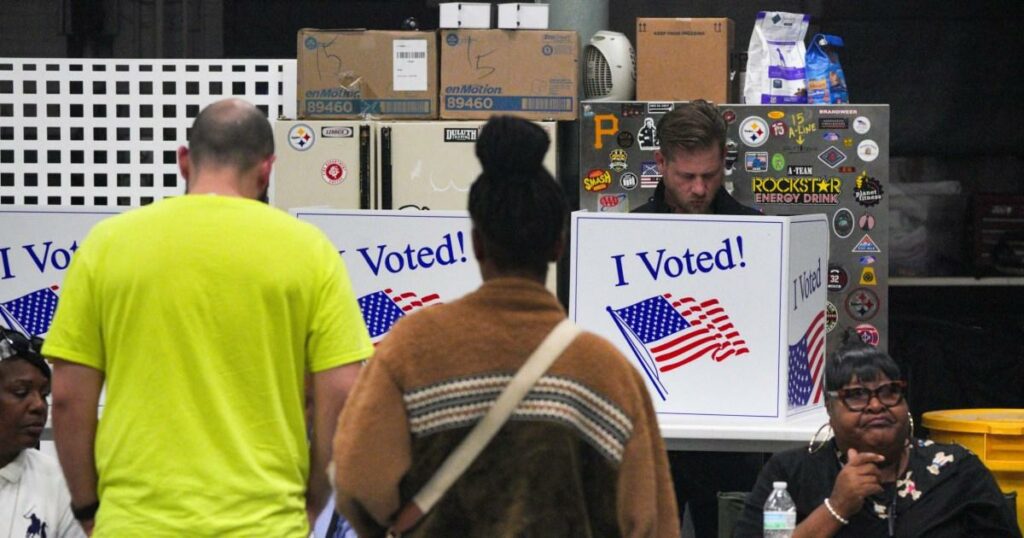Four years after leaving the White House, Donald Trump has won the 2024 US election, after pulling ahead of Kamala Harris in key battleground states.
These include Texas, Florida, Kentucky and Tennessee. Missouri, Arkansas, Iowa, North and South Dakota and Utah are among the other states going red.
The states with the largest electoral votes that Kamala Harris has won include New York, California, Massachusetts and Maryland. She has also won Connecticut, Rhode Island, Vermont, Virginia, DC, Illinois, Maine, Hawaii and Delaware.
However, the swing states – which don’t tend to consistently vote Democrat or Republican – have largely voted in Trump’s favour, with the Republican winning North Carolina, Pennsylvania, Wisconsin and Georgia.
Nevada, Michigan and Arizona are yet to finish counting, but Trump has now reached the required 270 Electoral College votes to win the election.
How does a candidate win the US election?
To view this video please enable JavaScript, and consider upgrading to a web
browser that
supports HTML5
video
Donald Trump will be returning to The White House (Picture: Getty Images)
To win the White House, a presidential candidate must secure 270 Electoral College votes.
These votes are allocated to US states based on their representation in Congress, which varies based on their population size.
Often a clear winner is known within hours of the polls closing, but it can also take weeks for an official tally to be released, as each state is left to carry out their own counting procedures.
Kamala Harris was able to count on 226 Electoral votes this election from states that reliably vote Democratic or lean Democratic, while Trump could count on 219 Electoral votes to go his way, according to Al Jazeera.
That means Harris needed to pick up 44 more votes to reach the 270 threshold, while Trump needed 51 more.
The seven ‘swing states’ together hold 93 Electoral votes.
What are swing states and why are they important?
‘Swing states’ are those of the 50 United States where both major political parties have a genuine chance of winning over the majority of voters in a presidential election.
For this election, the seven states that both the Democrats and Republicans agreed meet the criteria for being swing states, are: Nevada, Arizona, Georgia, North Carolina, Michigan, Wisconsin and, of course, Pennsylvania.
These are the key races that could change the outcome of the election:
When will Trump become president?
Donald Trump won’t take office as the new president until January 20, 2025.
This is because, despite winning the required 270 electoral college votes, there are still a few stages of the election left.
Election officials must confirm the official tally from each state, and this can in some cases take weeks. Oregon has the latest deadline to do this, on December 11.
Following this, on December 17, the appointed presidential electors from each state cast their official vote for the candidate who won in their state.
These votes will then be counted in Congress on January 6.
It is only after these steps that the inauguration can go ahead, which is a ceremony held on the steps of the Capitol building in Washington DC.
It is on this date that Trump will officially begin his term as president.
What is an Electoral College and why is it important in the election?
Election day in America can be confusing to understand(Picture: REUTERS)
When it comes to voting in America, what’s commonly thought of as “Election Day” is actually the first step in a two-part process.
In the first step—known as the presidential general election—voters cast their ballots for the candidates they want to become president and vice president.
More Trending
Read More Stories
Then comes the second step, which doesn’t involve the general public but instead relies on the Electoral College to cast the decisive votes.
What is the Electoral College?
The Electoral College is a unique system used in the United States to elect the president and vice president. Rather than deciding the winner by popular vote alone, the Electoral College assigns a set number of “electors” to each state, and these electors ultimately cast the votes that determine the election’s outcome.
It can be quite tricky to get your head around what this means, so let’s break it down.
Imagine a voter in Texas—which has 40 electors—casts their ballot for Trump. Technically, they aren’t directly voting for Trump himself; they’re voting for a group of 40 electors who will then cast their votes for Trump.
In other words, that Texan is essentially choosing the electors who will go on to elect the president.
Get in touch with our news team by emailing us at webnews@metro.co.uk.
For more stories like this, check our news page.
MORE : Hilary was gracious in 2016 — but eight years on we owe Trump nothing
MORE : Kamala Harris calls Donald Trump to concede defeat in US election
MORE : How many terms can a president serve — is this definitely Trump’s last?
Get your need-to-know
latest news, feel-good stories, analysis and moreThis site is protected by reCAPTCHA and the Google Privacy Policy and Terms of Service apply.
Source link : http://www.bing.com/news/apiclick.aspx?ref=FexRss&aid=&tid=672c2273775947228eaba6249711e9a2&url=https%3A%2F%2Fmetro.co.uk%2F2024%2F11%2F06%2Fwinning-us-presidential-election-far-21933535%2F&c=13701091676786481353&mkt=en-us
Author :
Publish date : 2024-11-05 10:03:00
Copyright for syndicated content belongs to the linked Source.
